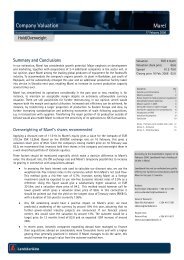Ársskýrsla Landsbankans - Landsbankinn
Ársskýrsla Landsbankans - Landsbankinn
Ársskýrsla Landsbankans - Landsbankinn
Create successful ePaper yourself
Turn your PDF publications into a flip-book with our unique Google optimized e-Paper software.
Notes to the Consolidated Financial Statements<br />
3. Significant accounting policies (continued)<br />
Financial assets and liabilities (continued)<br />
(g) Impairment of financial assets (continued)<br />
Impairment of loans and advances (continued)<br />
The present value calculated for estimated future cash flows of a collateralised financial asset reflects the cash flows that may result from<br />
foreclosure, less the costs involved in obtaining and selling the collateral, whether or not foreclosure is probable.<br />
In order to conduct a collective evaluation of impairment, loans are grouped on the basis of similar credit risk characteristics on the basis of the<br />
Group’s grading process, which considers asset type, collateral type, industry, past-due status and other relevant factors. These characteristics are<br />
appropriate for estimating future cash flows in groups of such loans by indicating the debtors’ ability to pay every amount due according to<br />
contractual terms.<br />
Groups of loans are collectively evaluated for impairment on the basis of expected cash flows and of peer review regarding assets with similar credit<br />
risk characteristics. Such peer review is also adjusted on the basis of current observable data, in order to reflect the effects of current conditions that<br />
did not affect the period on which peer review was originally based and to remove the effects of previous loss factors which no longer exist.<br />
Estimates of changes in future cash flows in groups of assets are consistent with changes in observable data from period to period, for example<br />
changes in property prices, payment status, or other factors indicative of trends in the probability and magnitude of Group losses. The Group<br />
regularly reviews its methodology and assumptions for estimating future cash flows in order to minimise discrepancies between estimated losses and<br />
actual loss experience.<br />
When a loan is uncollectible, it is written off against the provision for loan impairment in the statement of financial position. Loans are written off<br />
after all the necessary procedures have been completed, as set out in Group lending policies, and the amount of loss has been determined. Any<br />
subsequent recovery of an amount previously written off is recognised in the income statement in the line item "Net impairment loss on loans and<br />
advances".<br />
If the amount of the impairment loss decreases in the subsequent period and the decrease can be related objectively to an event occurring after the<br />
original impairment was recognised, the previously recognised impairment loss is reversed by adjusting the allowance account. The amount of<br />
reversal is recognised in the income statement in the line item "Net impairment loss on loans and advances".<br />
Renegotiated loans<br />
Where p possible, , the Groupp seeks to restructure loans rather than to take possession p of collaterals. This mayy involve extendingg the payment py<br />
arrangements and an agreement of new loan terms. Loans which are impaired and whose terms are renegotiated are not considered to be new loans.<br />
Once the terms have been renegotiated these loans are no longer considered past due and any subsequent impairment is measured using the original<br />
effective interest rate as calculated before the modification of terms. Management continuously reviews renegotiated loans to ensure that all criteria<br />
are met and that future payments are likely to occur. These loans continue to be subject to individual or collective impairment assessment. Loans<br />
which are not individually impaired and whose terms are renegotiated are accounted for as new loans. Accordingly, the original loans are<br />
derecognised and the renegotiated loans are recognised as new loans.<br />
Cash and cash equivalents<br />
For the purpose of the statement of cash flows, cash and cash equivalents are defined as cash, unrestricted balances with the Central Bank and<br />
unrestricted balances with financial institutions.<br />
Bonds and equities<br />
Bonds and equities which are classified as at fair value through profit or loss are recognised at fair value in the statement of financial position both<br />
initially and subsequently to initial recognition. Transaction costs are recognised directly in the income statement. Gains and losses arising from<br />
changes in fair value are recognised directly in the consolidated income statement in the line items "Net gain on financial assets and liabilities held<br />
for trading" and "Net gain on financial assets designated as at fair value through profit or loss", respectively. The gains and losses include interest<br />
income on bonds but exclude foreign exchange gains and losses, which are included in the line item "Net foreign exchange gain (loss)".<br />
Bonds which are classified as loans and receivables are initially measured at fair value plus directly attributable transaction costs, and are<br />
subsequently measured at amortised cost using the effective interest method. Accrued interest is included in the carrying amount of the bonds and it<br />
is recognised in the line item "Interest income" in the income statement.<br />
NBI hf. Consolidated Financial Statements 2010 15<br />
All amounts are in ISK million<br />
Allar upphæðir eru í milljónum króna Ársreikningur 2010 115



